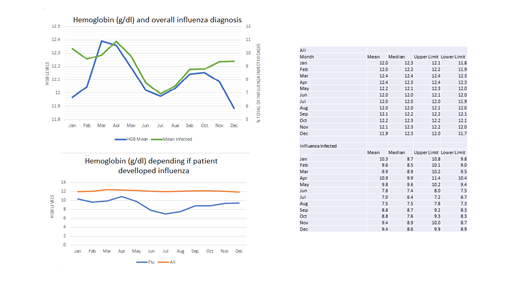Iron deficiency anemia (IDA) screening in children, and its treatment is standard in general pediatrics. IDA has been linked to developmental concerns. However, iron supplementation recently has been shown to have risks in resource limited environments as it seems to be associated with increased risks of infections. The role of iron in bacterial survival is well established. However more difficult to explain are reports linking iron supplementation to higher rates of respiratory illness in children. Recent studies have identified hepcidin as an important mediator between inflammation from common infections, and iron repletion status (Prentice et al 2019). In the current study we hypothesized that overall hemoglobin levels in infants may fluctuate depending on birth cohorts, as 1) exposure to respiratory illnesses peaks in winter months, and 2) children aged 6-12 months have the highest incidence of respiratory illness of all age groups (up to 6-8 upper respiratory infections per year). Institutional review board permission (Children Health Care of Atlanta), was obtained and the billing registry, laboratory and patient records from an multiethinic urban clinic (n= 7,616) were reviewed. Influenzas' infection was defined as a patient presenting with an acute illness and a positive rapid influenza test. Hemoglobin was obtained at 9 to 12 months routine visit by capillary draw and point of care measure (HemoCue hb). A total of 1236 patient files were reviewed from 2007 until 2018. Each year was examined separately and then overlapped. Influenza rates were lowest in the summer, rose starting September, and peaked during the winter months. In the first year of life, hemoglobin levels peaked in March, with lowest levels observed in July and December. Infants with a diagnosis of influenza had lower hemoglobin levels and more pronounced fluctuations. At age 7-9 months, medial hemoglobin was 12.1 (95% confidence interval [CI] ±0.026) g/dl and for those infected with influenza 9.8% 95% CI ±0.138). These observations have implications regarding screening, lower limits of normal may vary during the year. supplement. Other viruses also occur during the winter months and could play a role. These results require further validations.
No relevant conflicts of interest to declare.
Author notes
Asterisk with author names denotes non-ASH members.


